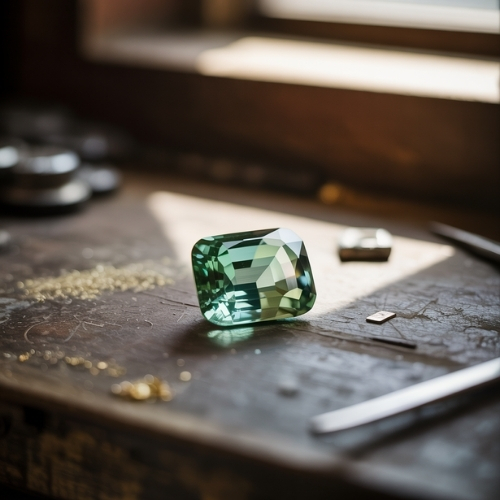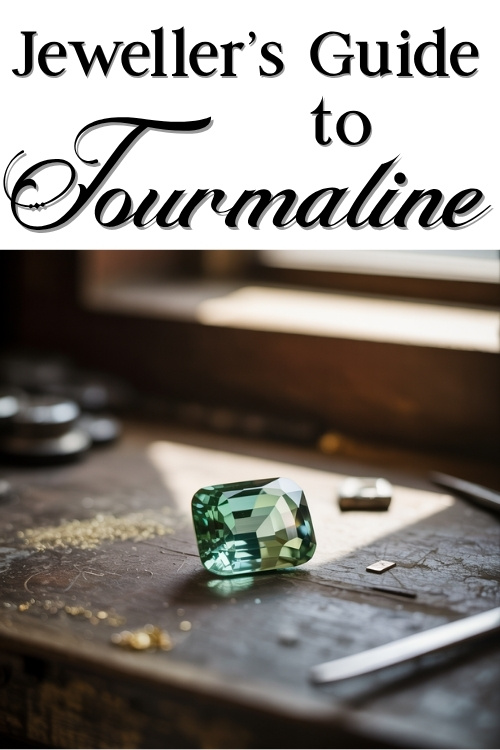Tourmaline is a gemstone of endless possibilities. With a colour palette spanning from the deepest blue to the richest pink, and even bi-coloured combinations, tourmaline offers an extraordinary range of expression for jewellery designers. Whether you’re drawn to the classic elegance of green or the playful brilliance of watermelon tourmaline, this gem brings both beauty and versatility to your bench.
Basic Identification Information
Name & Synonyms
Tourmaline.
Multiple trade names exist for tourmaline, often based on the gems colour, I’ve included a list at the end of this post.
Species
Tourmaline
Colour Range
Purple, red, orange, yellow, green, pink, blue, colourless, black, brown.
Refractive Index
1.615 – 1.655
Birefringence
0.013 – 0.040
Optical Sign
Uniaxial –
Pleochroism
Weak to strong and 2 colours.
Specific Gravity
3.00 – 3.26
Fluorescence
Weak to no response to UV light.
Lustre
Vitreous (glass-like)
Clarity
Varies widely with a gem being just as likely to be eye clean as heavily included.
Gems Often Mistaken For
Spinel, Garnet, Ruby, Topaz
Mohs Hardness
7 to 7.5
Wearability
Good. Suitable for most jewellery types, though care should be taken to protect it from knocks and scratches.
Birthstone
October (shared with opal)
Spotting Synthetic (Lab-Grown) Tourmaline
Lab-created tourmaline is extremely rare, but imitation stones (such as coloured glass or synthetic spinel) are common. These lack pleochroism and display unusually uniform colour or air bubbles under magnification.
Common Treatments
Heat treatment is commonly applied to lighten or intensify tourmaline’s colours, particularly greens, blues, and pinks. This is considered a stable enhancement and typically does not affect the gem’s durability.
Durability & Setting Considerations
Tourmaline is a reasonably durable gemstone, with a Mohs hardness of 7 to 7.5, making it suitable for most types of jewellery. However, like many coloured gems, it isn’t indestructible. Its internal crystal structure can create planes of weakness, which means it may chip or fracture if struck sharply, particularly in directions where cleavage is present.
When designing rings or other high-contact pieces, it’s wise to consider protective settings. Bezel and halo settings offer added security by shielding the edges of the stone, making them ideal for everyday wear. For earrings and pendants, where the gem is less likely to encounter knocks, prong settings can safely showcase the stone’s brilliance and colour.
If heat-related work is required after setting, proceed with caution. Tourmaline is sensitive to high temperatures and should never be exposed directly to a jeweller’s torch. Always use a heat sink and work at a distance to protect the gem from thermal shock.
Care Instructions
Cleaning
Warm, soapy water and a soft brush are safest. Avoid ultrasonic or steam cleaning as tourmaline often contains inclusions that may be heat or pressure sensitive.
Storage
Store separately from harder gems like sapphires and diamonds. Soft cloth pouches are ideal.
Daily Wear
Most tourmalines can be worn daily in protected settings. Caution is advised for rings worn during physical activity or manual work.
Market & Ethical Notes
Tourmaline is mined in various locations worldwide, including Brazil, Mozambique, Nigeria, Madagascar, and Afghanistan.
Its value depends heavily on colour, clarity, and origin, with Paraiba tourmalines (neon blue-green) among the most prized and expensive.
Due to the high demand and limited supply of Paraiba material, ethical concerns have arisen around some mining practices. As always, sourcing from suppliers who prioritise traceability and fair labour is essential.
Symbolic & Spiritual Meanings
Tourmaline is widely regarded as a stone of protection, emotional healing, and energetic balance. It’s often used to ground the wearer and clear away negativity, making it a favourite in spiritual and wellness practices.
Different colours of tourmaline are believed to carry unique properties. Green is linked to the heart chakra and emotional growth, pink supports love and compassion, and black is thought to shield against negative energies and stress.
Because of its rich symbolism and wide colour range, tourmaline is a popular choice for spiritual jewellery, meditation tools, and chakra-based designs.
🔗 Dive deeper into Tourmaline’s Symbolic & Spiritual Meanings
Etymology
The word “tourmaline” comes from the Sinhalese word toramalli, meaning stone with mixed colours. This name was originally used for a variety of coloured stones shipped from Sri Lanka, many of which turned out to be tourmaline, a gem as varied and multicoloured as the name suggests.
🔗Curious about how tourmaline was viewed in ancient cultures? Explore its fascinating myths and legends (coming soon)
Varieties and trade names
Achroite – colourless
Canary Tourmaline – bright yellow
Cat’s Eye Tourmaline – a tourmaline stone that displays chatoyancy
Chrome Green Tourmaline – a rich, intense green colouring
Indicolite – Blue tourmaline, including purplish Blue and greenish Blue
Paraiba Tourmaline – Green, blue or purple that is so highly saturated it looks neon
Rubelite – Red tourmaline, including orangey Red and purplish Red
Siberite – Purple (a vary rare type of tourmaline)
Veredelite – Green, including bluish Green and yellowish Green
Watermelon Tourmaline – a bi-coloured or tri-coloured variety that is pink and green (sometimes there is also a band of yellow between the green and pink).
📌 Save this jeweller’s guide to tourmaline for quick reference next time you’re working with this stunning gem.


